Feb-02-19
 | | KEG: This seeming mismatch produced some instructive points, even if the play was spotty. Going into this 11th round encounter, Marco was in fourth place, a full point behind 3rd-place Maroczy and just a half-point ahead of 5th place Burn. Jacob, who eventually finished dead-last in this tournament, was only a half-point ahead of cellar-dwelling Bardeleben. Thus, Marco needed a win and had reason to be confident. The game, however, was tougher than Marco probably expected. 1. e4 e5
2. Nf3 d6
Marco perhaps thought that Philidor's Defense would allow Jacob plenty of rope to hand himself (as he had been doing in most of his games to this point in the tournament). 3. d4 Nd7
Passive and less-frequently played than 3...exd4, but a reasonable and respected alternative. 4. Bc4 c6
"!"--Tournament Book
The most popular line. 4...exd4 is also OK. Either move gives White some advantage. 5. dxe5
Relieves the tension in the center, but still a reasonable choice. 5. 0-0 has more often been played. Both moves have their points and either is OK. 5... dxe5
5...Nxe5 and 5...Qa5+ are interesting alternatives. The position after the text (5...dxe5) was:

click for larger viewThe following portion of the game was dominated by the attack and defense of f7. 6. 0-0
As the Tournament Book pointed out, 6. Bxf7+ ?! KxB 7. Nxe5+ Ke8 gets White nowhere (e.g., 8. Qh5+ ?! g6 9. Nxg6 Ngf6 10. Qh4 Bb4+ with Rg8 to follow). 6... Be7
Ignoring the risk to f7. 6...b5 was better.
7. Be3
This "novelty gives away all of White's advantage. 7. Ng5 was best, e.g., 7...BxN 8. Qh5 Qe7 9. QxB QxQ 10. BxQ leaving White with the two Bishops, the better development and the initiative. 7... Ngf6
8. Nbd2 Qc7
8...0-0 would have avoided the upcoming risks at f7. At this point, however, Black had time for the text. 9. c3
Jacob might have anticipated Marco's next move with 9. a4. The text, however, is also reasonable. 9... b5
The Tournament Book gave the following (flawed) line after 9...0-0 (which with best play was fine): 10. Ng5 (10. a4 is probably better) b5?? [Black would be fine after 10...Bd6 or 10...Nb6] 11. Bxf7+ (a killer!) RxB (11...Kh8 was perhaps slightly better, but Black would still be lost) 12. Qb3 and Black is dead (12...Nd5 13. NxR KxN 14. exN leaving White up the exchange with a strong remaining initiative). The position was now:

click for larger view10. Bb3?
Very weak. White would still be OK with 10. Be2. Also good--and most exciting--was 10. Bxf7+ e.g., 10...KxB 11. Ng5+ [or 11. Qb3+ first] Ke8 12. Qb3 Nf8 [not 12...Rf8 13. Ne6] 13. Qf7+ Kd8 resulting in an unclear position in which White has decent compensation for the sacrificed piece. Jacob's move handed the initiative to Marco.
10... Bb7/
Either not realizing the danger or rightly guessing that Jacob would not figure out how to realize his advantage. Marco would have had a good game with 10...0-0 or 10...Nc5. The position was now:

click for larger viewAs I will discuss in my next post on this game, Jacob missed a fine chance here and-through weak play--had what was probably a strategically lost position by move 13. |
|
Feb-02-19
 | | KEG: Post II
In the diagrammed position with which I ended my last post, Jacob could have obtained at least equal chance with 11. Bxf7+. One possible line is 11...KxB 12. Ng5+ Ke8 (obviously not 12...Kf8 13. Ne6+ winning the Queen, and if 12...Kg8 13. Qb3+ wins back the piece immediately with a big edge to White) 13. Qb3 Nf8 (anything else loese) 14. Ndf3 Bd6 15. Rad1 Rd8 16. RxB!RxR 17. Nxe5 Rg8 18. Bc5 and White, though down a Rook for two pawns, has powerful pressure and probably at least equal chances. If Jacob was reluctant to enter into the 11. Bxf7+ thicket, he could have played 11. Nh4 with about an even game. Instead, Jacob played the very poor:
11. Ng5?
This attacks f7, but gives Black time to defend. 11... 0-0
Forced, but sufficient to give Black the better game. 12. f4
Creating new weaknesses for himself. 12. h3 or 12. a4 were better and give White a playable game. 12... c5?
This left his b-pawn hanging and did nothing to halt White's attack. Marco should have played 12...h6. The position was now:

click for larger viewJacob now had a simple conbination that would have kept him very much in the gameL 13. Bxf7+ RxB 14. NxR KxN 15. Qb3+ followed by 16. Qxb5. But Jacob missed this and instead played:
13. fxe5?
Among other things, this awful move brings a new Black piece to the defense of f7: 13... Nex5
14. Bf4
If Jacob was relying on this pin, he must have been brought back to Earth after Marco's next move. 14... c4
So much for White's attack on f7.
Material is even, but White has an isolated and weak e-pawn and Black's pieces are far better posted. 15. Bc2 Qc5+
16. Kh1 Ng6
17. Qf3
Now we have:
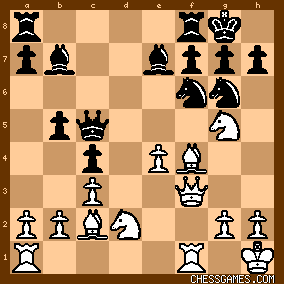
click for larger view17... Rad8
Missing his chance to rid himself of White's f4 Bishop and seize likely decisive initiative with 17...NxB and 18...Nh5. 18. Be3
Preserving his Bishop and gaining a tempo with his attack on the Black Queen. 18.. Qe5?
Wrong square. On e5, Marco's Queen can be attacked. He should have played 18...Qc8. 19. Qe2
Making room for a Knight on f3.
19... a6
Belatedly dealing with his undefended b5 pawn.
20. Ndf3
Gaining a tempo.
20... Qc7
The position was now:

click for larger viewJacob was now very much back in the game. But, as I will discuss in my next post on this game, from here Jacob badly erred and was soon seemingly hopelessly lost (a fate from which some bad mistakes by Marco were to rescue Jacob). |
|
Feb-03-19
 | | KEG: Post III
Jacob made a good start from the diagrammed position with which I ended my last post: 21. e5!
Transforming the isolated e-pawn from a liability to a weapon. 21... Ng4
22. Bd4
Re-enforcing the e-pawn and blocking any activity by Marco on the d-file. 22... Rde8
The position was now:

click for larger viewJacob had reasonable chances of holding what had a bad game for him at this point, but now floundered badly. With 22. Rae1 or 22. BxN (eliminating one piece attacking his e-pawn), Jacob could have had every hope of survival. But now he fell apart: 23. h3?
Effectively blundering away a pawn. With 23...N4xe5 24. NxN BxN Marco would have been a pawn up with no compensation for Jacob. But... 23... BxN(g5)?
if Marco thought this was a harmless transposition of moves, he was wrong. With 24. hxN, Jacob--though with an ugly pawn structure--would have retained material equality and have had real chances to stay in the game. But Jacob--pursuing an illusion--blundered with: 24. NxB?
Now, Jacob did lose a pawn:
24... N4xe5
The position was now:

click for larger viewJacob was now simply down a pawn. But he apparently thought he had a combination in hand to save the day. Alas for him, it was flawed. But a miracle was to strike and he would soon be back in the game despite his mnis-calculation: 25. Qh5
A move that looks a lot stronger than it was.
25... h6
This should have put an end to whatever hopes Jacob harbored of some sort of lightning attack, the position now being: 
click for larger view26. Nxf7?
"?"--Tournament Book.
The move on which Jacob seems to have relied. As a theoretical matter, Jacob's best chances here lay in 26. Ne4. Even 26, BxN (again speaking theoretically) was better than the text. But both players seem to have been operating under the same delusion, since Marco played: 26... RxN?
"?"--Tournament Book.
As was pointed out in the Tournament Book, Marco would have won easily with 26...Qc6! which threatens mate in one and defends the g6 Knight. White would then have nothing better than 27. Nxh6+ gxN 28. RxR+ RxR 29. Rg1 Rf1! 30. Qe2 RxR+ 31. KxR Nf4 32. Qe4 QxQ 33. BxQ BxB 34. BxN Nxg2 with an easily won ending a full piece up. The text, however, gave Jacob a heartbeat, though the game was still almost certainly won for Black. 27. BxN (g6) NxB
He could also have played 27...RxR+ here. The Tournament Book's proposed 27...Bxg2?! 28. KxB Qc6+ ["!"--Tournament Book] is certainly no improvement, and after 29. Kg1 RxR+ 30. RxR NxB leaves White some chance--though a pawn down--because his Bishop is better than Black's Knight. 28. QxN
The position was now:

click for larger viewMarco still had a likely win here with the simple 28...RxR+ 29. RxR Re2! 30. Rg1 Rxb2 leaving White a pawn down and in a horribly cramped and vulnerable position. However, and as I will discuss in my next post on this game, Marco erred yet again here and allowed Jacob to escape to a Bishops of opposite colors ending that he might well have been able to hold. |
|
Feb-03-19
 | | KEG: Post IV
Marco missed the win I discussed in my last post in the diagrammed position with which I ended and instead of 28...RxR+ (or 28...Rfe7 which also likely wins) played: 28... Re2?
Marco may have felt that it couldn't be bad to have his pieces gang up on g2, but Jacob had a saving resource: 29. RxR
29. QxR+ is not as good because after 29...QxQ 30. RxQ Black has the intermediate move 30...Bxg2+ winning a pawn or two (e.g., 31. Kg1 KxR 32. a4 Bxh3 33. axb5 axb5 34. Ra7+ Ke8 35. Rxg7 Rxb2 leaving Black up two pawns but with uncertain winning chances because of the Bishops of opposite colors. The text avoids this pitfall. 29... QxR
30. QxQ+ KxQ
This left:

click for larger viewJacob then saved his b2 pawn with:
31. Rf1+ Ke6
32. Rf2 RxR
33. BxR
The following Bishops of opposite colors ending was now reachedL 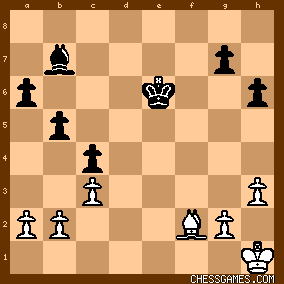
click for larger view"Tabula rasa!" -- (Tournament Book)
Though Bishops of opposite color endings are usually drawn, here--as Marco perceived--Black has the advantage because of the far better placement of his King. While the game--with best play--is almost certainly a draw, White needs to play with care to deal with the coming invasion by the Black King. Jacob did not play the ending well, and Marco was an excellent end-game player. So perhaps the result was predictable. 33... Kd5
Invading on the White squares, which Jacob's King marooned on h1 cannot prevent. 34. Bd4
Creating a diversion. So far so good for Jacob. Perhaps a clearer way to play for a draw was to play his Bishop to c5 and later b4 with a possible a4 to follow. 34... g6
More accurate than 34...g5
35. Kg1
35. a4 immediately was also good.
35... Ke4
The position was now:
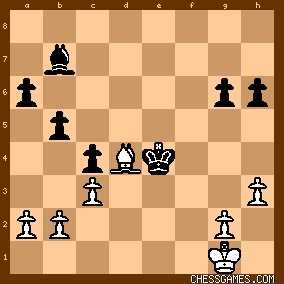
click for larger viewCan White save this game?
36. b3?
Not like this he can't.
"?"--Tournament Book.
The Tournament Book gives 36. Bg7 as best for White, but only considers 36...h5? as a response (which seems to allow White to hold with--to quote the Tournament Book--37. a4 ["!"--Tournament Book] bxa4 38. Bf8). But if 36. Bg7 then 36...Kd3! is crushing. The way to draw was with 36. a4! or 36. Bc5! White must secure his Queen-side and does not have time to attack the Black pawn on h6. After Jacob's 36. b3?, the position was:

click for larger viewAs I will discuss in my next post on this game, the game was now lost for Jacob, though he struggled on for another fifteen moves. |
|
Feb-03-19
 | | KEG: Post V
Jacob's awful 36. b3? messed up his chances to construct a Queen-side blockade (e.g., Bishop on a3 and pawns on b2 and c3 after playing a4). Now it was time for Marco to clean up. 36... Kd3
This wins, but makes matters exciting. Marco had a clear win with 36...cxb3 37. axb3 Kd3 (since 38. b4 allows 38...a5! 39. bxa5 b4! and anything else allows 38...a5). 36...b4 also wins and was better than the text.
Back to Marco's actual move: 36...Kd3
37. bxc4
37. b4 loses to 37...a5! 38. a3 (if 38. bax5 b4!) a4 and either White's a3 or c3 pawns must fall. The position was now:

click for larger view37... b4!
"!"--Tournament Book.
Black now gets a powerful (to put it mildly) passed pawn on c3. 38. Bg7
I see nothing better for White.
38... bxc3
This left:
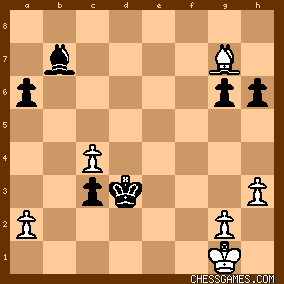
click for larger view39. Kf2?
This is too slow and gives Black play on both sides of the board. The game is almost certainly lost anyway, but White might be able to put up a bit of a fight with 39. Bxh6 Kxc4 40. Kf2 [if 40. g4 Kb4 41. Bc1 (41. Bf8+ Ka4 42. Bg7 c2 43. Bb2 Bd5) Bd5] Kd3 41. Ke1 Bxg2 42.h4 Kc2 43. Bg7 a5 Black still should win, but it's not a cakewalk. 39... Kxc4
"!"--Tournament Book.
The Tournament Book notwithstanding, this is sloppy and gave Jacob a ray of hope. 39...h5! was a killer. White must now play 40. Ke1 abandoning the g2 pawn in order to muster any kind of defense on the Queen-side, leaving White helpless, since 40...Bxg2 41. h4 loses to 41...g5! 42. hxg5 c2 43. Bb2 Be4 makes it impossible to defend the Black Queening threats on both sides of the board. After the text, there was still play in the position, which was now: 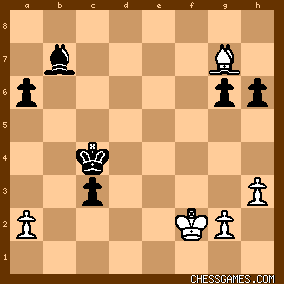
click for larger view40. Ke2
The Tournament Book devoted considerable analysis in an attempt to demonstrate that 40. Bxh6 loses. But it only considered the variation 40. Bxh6 Kd3 41. g4, which does indeed lose after (quoting the Tournament Book) 41...Kc2 42. h4 Bd5 43. a4 Bf7 44. Ke3 Kd1 45. Kd4 c2 46. Kc5 c1(Q)+ 47. BxQ KxB 48. Kb6 Bc4 49. h5 (49. Kc6 or 49. Kc5 allow longer resistance) g5 (!-Tournament Book) 50. h6 Bd3. But in the above line, 41. Ke1 is much better. Black may yet still win after 41...Bxg2 42. h4 Kc2 43. Bg7 Bd5 44. a3 a5 45. Bd4 Kb3 46. Kd1 Kb2 but there's work to be done. All in all, and given this last line, 40. Bxh6 looks best. Anyway, back to the actual game:
40... Bxg2
So Jacob was now down two pawns, but the position was still tricky: 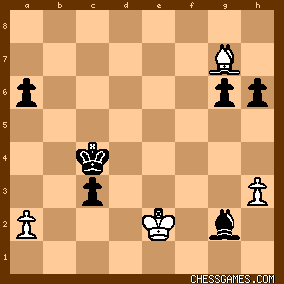
click for larger viewAs a result of Marco's weak 39th move, the win was still not trivial. I will discuss the play from here in my next post on this game. |
|
Feb-03-19
 | | KEG: Post VI
41. h4
"!"--Tournament Book.
Facing threats on both sides of the board, in order to survive, Jacob would have to use his King to defend one side. But he faced an immediate decision: should he trade off h-pawns of keep the h-pawns on the board. 41. h4, though it doesn't save the day, was probably the best try. If 41. Bxh6 Bxh3 42. Bc1 [42. Bishop elsewhere on the diagonal or 42. a3 are no better] then Black wins witt 42...Bg4+ 43. Ke1 Kd3 44. Bf4 Be6 45. a4 a5 (leaving White with no more tempos with the a-pawn) 46. Kd1 Kc4 47. Kc2 Bf5+ 48.Kc1 Kb3 49. Be5 g5 50. Kd1 g4 and Black can not stop Black on both wings. So Jacob's 41. h4 was indeed the best move available to him. 41... g5
41...h5 was faster, e.g., 42. Ke1 Bf3 43. Be5 a5 44. Bf6 a4 45. Kf2 (45. Be5 Kd3) Be4 46. Ke2 Bd3+ 47. Kd1 Bb1 and Black goes three pawns up with a clear win. But even after the text, Black can win, albeit with more difficulty. 42. h5
"!"--Tournament Book. The only move that creates any problems for Black. The position was now:

click for larger viewHow should Black proceed?
42... c2?!
42...Bd5 or 42...Bc6 all look simpler, but if Black loses both of his King-side pawns it looks like White can set up a blockade on the Queen-side even if he loses his a-pawn. 42...g4 also looks promising, but a win is tough here as well. All in all, I finally concluded that Marco's move is best. 43. Kd2
43. Bb2 g4 does not look pleasant for White.
43... Be4
44. Bxh6 g4
45. Bf4
The position was now:
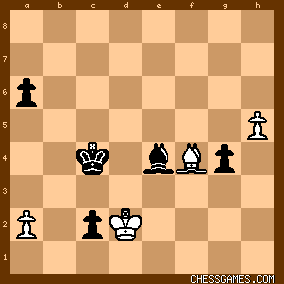
click for larger viewNow what?
45... a5
"!"--Tournament Book.
A better plan seems to be to march the King over to the King-side beginning with 45...Kd5 (or 45...Kd4) e.g., 45...Kd5 46. h6 Ke6 47. Kc1 Kf6 48. Kd2 Kg6 49. a4 Kh5 50. a5 Kh4 51. Ke2 g3 52. Kf1 kh3 53. Kg1 Kg4 54. Be3 Kf3 55. Bg5 Ke2 and now White will have to give up his Bishop to stop the c-pawn from Queening (having distracted the White King to g1 to keep an eye on the g-pawn. The text, however, still seems to win.
46. h6
The best try.
46... a4
White's defensive resources are getting strained to their limits. 47. Bb8 Bh7
48. Bf4 Kd4
This left:
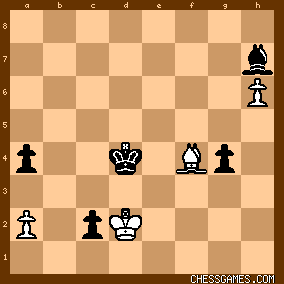
click for larger view49. Ke2
Jacob cracked at the strain of trying to hold the game. He should have just shuffled his Bishop and hoped for a miracle. After the text, the game was over. 49... Ke4
"!"--Tournament Book.
49...g3 would have been equally effective.
50. Bc1 g3
50...Bg8 or 50...Bg6 were equally crushing.
51. Be3
"?"--Tournament Book.
This is fatal, but everything else also loses. The Tournament Book'suggested 51. Kf1 loses to 51...Kf3 52. Bg5 (nothing is better) g2+ 53. Kg1 Ke2 54. Kxg2 Kd1 55. Kf2 c1(Q) 56. BxQ KxB 57. Ke3 Kb2 and with the Black Bishop controlling b1 the Black pawn must Queen. 51... g2
This left:

click for larger viewOne of Black's pawns must promote, e.g., 52. Kf2 g1(Q)+ 53. KxQ KxB 0-1 |
|
|
|
|





































